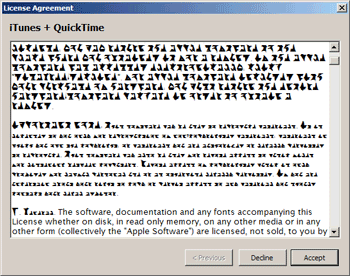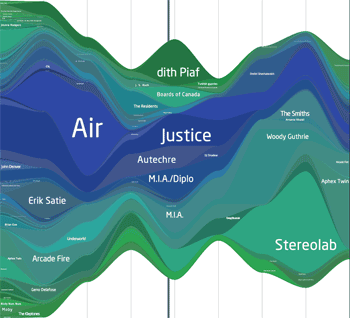 If you care about games as an artform, you definitely need to play Rez sometime. That pleasure
is now
easier; Rez was just remastered and released for $10 on
Xbox Live Arcade. Well worth the expense.
If you care about games as an artform, you definitely need to play Rez sometime. That pleasure
is now
easier; Rez was just remastered and released for $10 on
Xbox Live Arcade. Well worth the expense.
The conversion is good. The HD graphics look beautiful and the widescreen aspect works nicely. There's surround sound. A bit of online play in the form of leaderboards and downloadable replays. And yes, there's even trance vibrator (NSFW) support. And if you want to see how poorly we lived six years ago, you can play the original game too. Really, a perfect conversion. To be honest Rez doesn't have the best gameplay. It's a basic rail shooter with occasional frustrating dodging and the boss fights are tedious. What makes this game so important is the pure æsthetic joy of it, the fusion of music and trippy graphics and sensory overload. Video games have mostly become like movies, complex animations and sets and stories and intricate gameplay. Which is good when done well. Rez stripped all that cinematographic stuff away and focussed on a music and visual experience. And is deservedly well loved for that. At the time Rez felt unique and retro, but happily now we have lots of other good options for hypnagogic gameplay: Space Giraffe, Geometry Wars, Lumines. The look of these games is unique to gamer culture, not an emulation of movies. I cherish that. Be careful what you wish for. Pidgin is amazing in a lot of ways; it supports a lot of protocols, has simple plugins, a solid communications library, etc. But it also has the breathtaking hostility to usability of so many open source apps. A lot of the GUI details aren't quite right and the docs are downright arrogant. To be fair, Pidgin mostly works fine out of the box. Except the font is too small. No big deal, every app lets you configure the font, right? Ha! Just try the documented solution. Apparently I'm supposed to learn about GTK, and themes, and figure out where GTK places config files in Windows, then edit them with a text editor and insert 500 bytes of configuration directives for "imhtml-fix". There's a proposal to add font controls in Pidgin, but the answer from the developer is "I think more people should know how to modify their system configuration settings". Because you know, chatting with your friends without squinting should require you spend hours researching some GUI toolkit no other app on your system uses.
Update: I stumbled across the Pidgin Extended
Preferences Plugin. The page is incredibly coy; no download link
(it's here)
and no description of what the plugin actually does other than a
grudging "additional preferences that have been commonly called for in
the past from Pidgin". Which is why it doesn't show up on a search for
pidgin
font size. But if you click through the tiny screenshot
you'll see there's a configuration option for font sizes! It even
works! Well, once you figure out how to make a directory and copy a
DLL over manually.
PS: the default font size is 8 point. Damn kids.
The Road by Cormac McCarthy
I'm a big fan of post-apocalyptic novels so it was a nice surprise that America's favourite postmodern western novelist would tackle the genre. Or that it'd be an Oprah Book Club pick. It's a fantastic novel, grim and depressing and horribly compelling.
King Corn by Ian Cheney and
Curt Ellis
Burnout:
Paradise by Criterion Games
Today I thought I'd update my iPhone to 1.1.3 firmware. Here's the
hell I encountered.
(Yes, the phone is working again; plugging it into iTunes and waiting a few minutes seems to have now fixed it.)
Readers of my blog know I dislike everything
about iTunes. But I'm kind of charmed by the license agreement on my
most recent update.
 Apple should get a third party to build their Windows apps.
I used to be an academic, a grad student 1996-1999 doing the workshop
and conference tours. Write a small paper, propose it, take a trip to
present it. It was kind of fun because the MIT Media Lab was stupidly
overfunded, letting me do interesting if not productive things like wangle a trip to
Budapest.
The downside is that now, eight years later, I'm still getting spam about once a week inviting me to go to third-rate workshops. Like the "Conference on Knowledge Generation, Communication, and Management". Sounds hideous. I'm not in the business anymore, but a conference you've never heard of whose papers are published in a journal you've never heard of isn't a good sign. Neither is filling your conference up with papers from people you spam because ten years ago they were doing something vaguely related. And the program has the stench of the Semantic Web, which as everyone knows is a total academic rathole. This conference is at least in the US, albeit organized by someone in Venezuela. A lot of the spam I get is for conferences in small countries with no academic influence. Dear US grad students: a paper published in a workshop in Macedonia is not going to help you get a job at a top American university. I understand that my email address is on giant lists for Viagra spam. But what list am I on that I keep getting academic conference spam? At least the Viagra spam has amusing pictures.  Once a year I'm reminded of the good people of
Quitman, Mineola, and all the folks in God's East Texas. Because once I year I write property tax
checks for them on my vast oil empire.
Once a year I'm reminded of the good people of
Quitman, Mineola, and all the folks in God's East Texas. Because once I year I write property tax
checks for them on my vast oil empire.
"Vast" is a bit of an overstatement. I have no idea how much property I actually own since it's so split up. The taxes on a 0.0006741 royalty interest in 95 acres comes to about $0.05 a year. The taxes on 1/2 of 1/3 of 2/3 of 2/3 mineral interest in 473.8 acres would be more, but no one's drilling oil on that land right now. All told the yearly tax bill is about the cost of a steak in San Francisco. The royalties I earn would pay for a couple of steak dinners a year though, particularly with oil at $100 a barrel. The US is unusual in that the minerals under a piece of land can be owned separately from the surface rights to farm or develop that land. Texans took good advantage of that option in the early 1900s after oil was discovered and it's common for mineral rights to be owned and divided separately from the surface rights. My great-grandfather apparently took mineral interests in lieu of cash payments for some lawyering he did. And now we have an odd little family legacy. The administration of that legacy is a huge pain. It took me several years to transfer the mineral rights to my mother's heirs upon her death and the cost of filing all the papers outweighed a year's royalties. People offer to buy the royalties from time to time, but we keep them in the family because they're sort of fun and the offers are never very good. That, and I cherish the yearly ritual of getting a handwritten tax receipt from Mount Pleasant, TX (elevation 404 feet) for my payment of $3.66. They have good handwriting in east Texas.
I love services that passively record things I do. So I was
excited to find Audioscrobbler from last.fm. It silently watches my Winamp and
Squeezebox traffic and tells a server what I'm listening to. Simple,
well executed.
What last.fm is missing is doing anything useful with that data. The site has some complex dashboard social network thing that is impenetrable to me. And it has a music recommendation function which is pretty good, but too junked up by crappy quality free music to be enjoyable.
 I hope last.fm has already made the appropriate overture to provide these graphs themselves. Simplify the creation tool a bit, publish a PNG, and fix poor Édith's name and you've got a fine product feature. |
||
